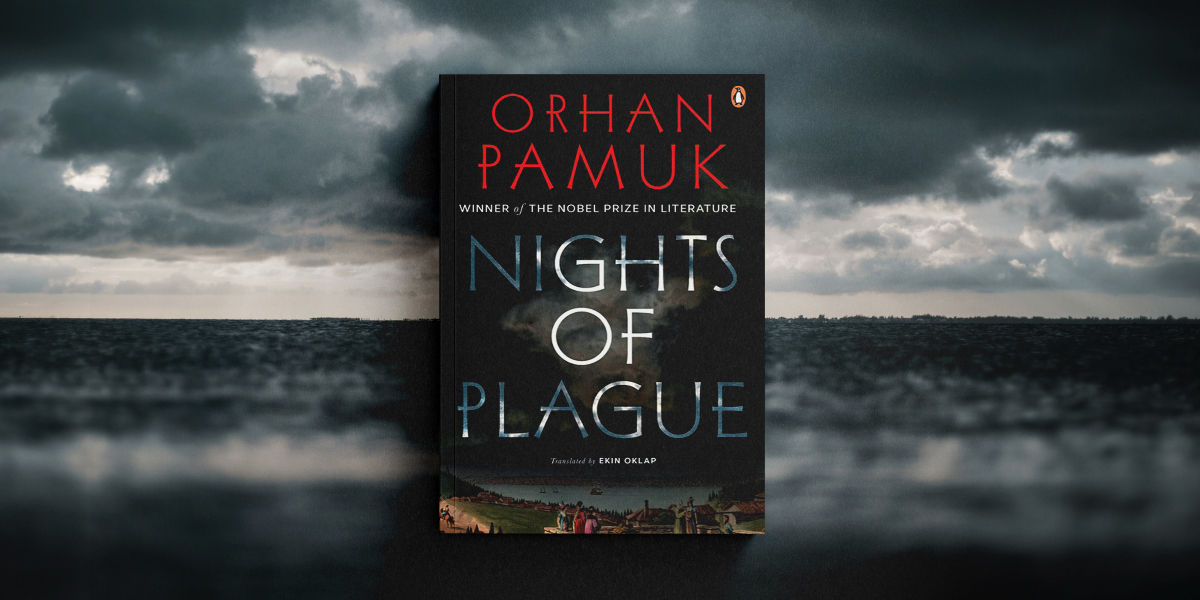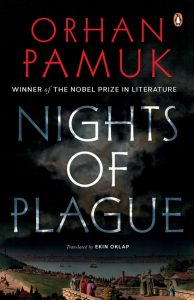
From the winner of the Nobel Prize in Literature: Part detective story, part historical epic—a bold and brilliant novel that imagines a plague ravaging a fictional island in the Ottoman Empire. Here’s an excerpt from Orhan’s Pamuk’s Nights of Plague.
*

Nights of Plague
Orhan Pamuk
In the year 1901, if a steamer with black coal-smoke pouring from its chimney were to sail south from Istanbul for four days until it passed the island of Rhodes, then continue south through dangerous, stormy waters toward Alexandria for another half day, its passengers would eventually come to see in the distance the delicate towers of Arkaz Castle upon the island of Mingheria. Due to Mingheria’s location on the route between Istanbul and Alexandria, the Castle’s enigmatic shadow and silhouette were gazed upon in awe and fascination by many a passing traveler. As soon as this magnificent image—which Homer described in the Iliad as “an emerald built of pink stone”—appeared on the horizon, ship captains of a finer spiritual disposition would invite their passengers on deck so that they could savor the views, and artists on their way to the East would avidly paint the romantic vista, adding black storm clouds for effect.
But few of these ships would stop at Mingheria, for in those days there were only three ferries that made regular weekly trips to the island: the Messageries Maritimes Saghalien (whose high-pitched whistle everyone in Arkaz recognized) and Equateur (with its deeper horn), and the Cretian company Pantaleon’s dainty vessel the Zeus (which only rarely sounded its horn, and always in brief bursts). So the fact that an unscheduled ferry was approaching the island of Mingheria two hours before midnight on the twenty-second of April 1901—the day our story begins—signaled that something unusual was afoot.
The ship with pointed bow and slender white chimneys closing in on the island from the north, stealthy as a spy vessel, and bearing the Ottoman flag, was the Aziziye. It had been tasked by Sultan Abdul Hamid II with transporting a distinguished Ottoman delegation from Istanbul on a special mission to China. To this delegation of seventeen fez-,turban-, and hat-clad religious scholars, army officers, translators, and bureaucrats, Abdul Hamid had added at the last moment his niece Princess Pakize, whose marriage he had recently arranged, and her husband, Prince Consort Doctor Nuri Bey. The joyous, eager, and slightly dazed newlyweds had not been able to fathom the reason for their inclusion in the delegation to China and had puzzled over the matter at great length.
Princess Pakize—who, like her older sisters, was not fond of her uncle the Sultan—was sure that Abdul Hamid had meant her and her husband some kind of harm by putting them in the delegation, but she had not yet been able to work out what the reason might be. Some palace gossips had suggested that the Sultan’s intention must be to drive the newlyweds out of Istanbul and send them to die in yellow fever–infested Asian lands and cholera-ridden African deserts, while others pointed out that Abdul Hamid’s games tended to be revealed only once he had finished playing them. But Prince Consort Doctor Nuri Bey was more optimistic.
An eminently successful and hardworking thirty-eight-year-old quarantine doctor, he had represented the Ottoman Empire at international public health conferences. His achievements had caught the Sultan’s attention, and when they had been introduced, Doctor Nuri had discovered what many quarantine doctors already knew: that the Sultan’s fascination with murder mysteries was matched by his interest in European medical advances. The Sultan wanted to keep up with developments concerning microbes, laboratories, and vaccinations and introduce the latest medical findings to Istanbul and across Ottoman lands. He was also concerned about the new infectious diseases that were making their way toward the West from Asia and China.
There was no wind in the Levant that night, so the Sultan’s Aziziye cruise ship was making swifter progress than expected. Earlier it had made a stop at the port of Smyrna, though no such stop had been declared in the official itinerary. As the ship had neared the misty Smyrna docks, one by one the committee’s delegates had climbed up the narrow stairwell that led to the captain’s quarters to request an explanation and had learned that a mysterious new passenger was to come on board. Even the captain (who was Russian) had claimed not to know who this passenger was.
The Aziziye’s mysterious passenger was the Ottoman Empire’s Chief Inspector of Public Health and Sanitation, the renowned chemist and pharmacist Bonkowski Pasha. Tired but still sprightly at the age of sixty, Bonkowski Pasha was the Sultan’s Royal Chemist and the founder of modern Ottoman pharmacology. He was also a semisuccessful businessman who had once owned a number of different companies producing rosewater and perfumes, bottled mineral water, and pharmaceuticals. But for the past ten years, he had worked exclusively as the Ottoman Empire’s Chief Inspector of Public Health, sending the Sultan reports on cholera and plague outbreaks, as well as rushing from one outbreak to the next, from port to port and city to city, to oversee quarantine and public health provisions on behalf of the Sultan.
Inspector of Public Health and Sanitation, the renowned chemist and pharmacist Bonkowski Pasha. Tired but still sprightly at the age of sixty, Bonkowski Pasha was the Sultan’s Royal Chemist and the founder of modern Ottoman pharmacology. He was also a semisuccessful businessman who had once owned a number of different companies producing rosewater and perfumes, bottled mineral water, and pharmaceuticals. But for the past ten years he had worked exclusively as the Ottoman Empire’s Chief Inspector of Public Health, sending the Sultan reports on cholera and plague outbreaks, as well as rushing from one outbreak to the next, from port to port and city to city, to oversee quarantine and public health provisions on behalf of the Sultan.
Chemist and pharmacist Bonkowski Pasha had often represented the Ottoman Empire at international quarantine conventions, and had written Sultan Abdul Hamid a treatise four years ago on the precautions that the Ottoman Empire should take against the plague pandemic that had begun in the East. He had also been specially appointed to combat the outbreak of plague in the Greek neighborhoods of Smyrna. After several cholera epidemics over the years, the new plague microbe from the East—whose infectivity (what medical experts termed “virulence”) had waxed and waned in time—had, alas, finally entered the Ottoman Empire too.
**
Get your copy of Nights of Plague from the nearest bookstores on Amazon.









